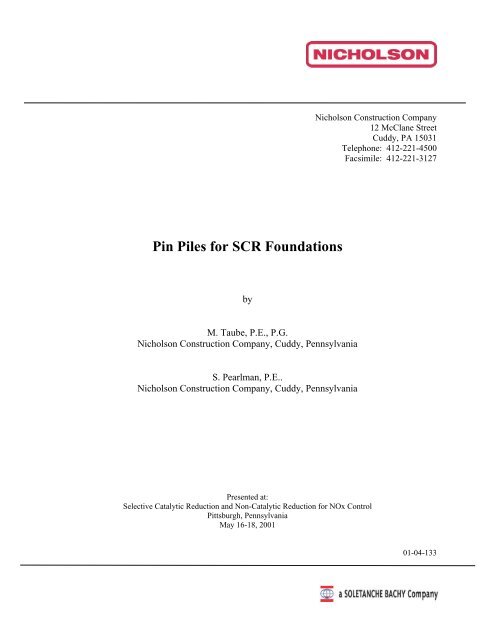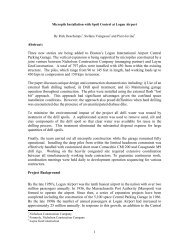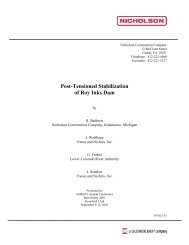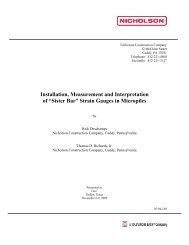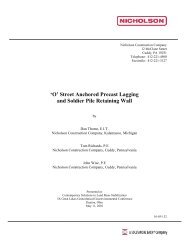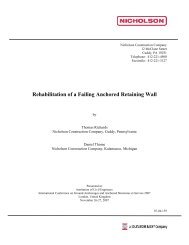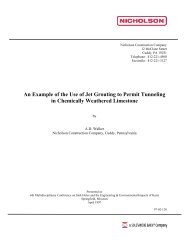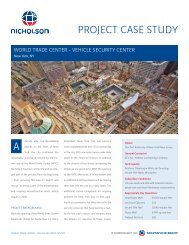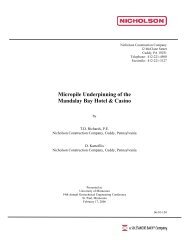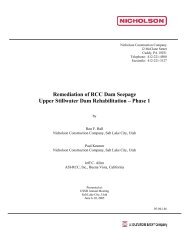Pin Piles for SCR Foundations - Nicholson Construction Company
Pin Piles for SCR Foundations - Nicholson Construction Company
Pin Piles for SCR Foundations - Nicholson Construction Company
Create successful ePaper yourself
Turn your PDF publications into a flip-book with our unique Google optimized e-Paper software.
<strong>Nicholson</strong> <strong>Construction</strong> <strong>Company</strong><br />
12 McClane Street<br />
Cuddy, PA 15031<br />
Telephone: 412-221-4500<br />
Facsimile: 412-221-3127<br />
<strong>Pin</strong> <strong>Piles</strong> <strong>for</strong> <strong>SCR</strong> <strong>Foundations</strong><br />
by<br />
M. Taube, P.E., P.G.<br />
<strong>Nicholson</strong> <strong>Construction</strong> <strong>Company</strong>, Cuddy, Pennsylvania<br />
S. Pearlman, P.E..<br />
<strong>Nicholson</strong> <strong>Construction</strong> <strong>Company</strong>, Cuddy, Pennsylvania<br />
Presented at:<br />
Selective Catalytic Reduction and Non-Catalytic Reduction <strong>for</strong> NOx Control<br />
Pittsburgh, Pennsylvania<br />
May 16-18, 2001<br />
01-04-133
Title:<br />
Authors:<br />
<strong>Pin</strong> <strong>Piles</strong> <strong>for</strong> <strong>SCR</strong> <strong>Foundations</strong><br />
Martin G. Taube, P.E., P.G. and Seth L. Pearlman, P.E.<br />
<strong>Nicholson</strong> <strong>Construction</strong> <strong>Company</strong><br />
12 McClane Street<br />
Cuddy, Pennsylvania 15031<br />
mtaube@nicholson-rodio.com/spearlman@nicholson-rodio.com<br />
Telephone: (412) 221-4500<br />
Fax: (412) 221-3127<br />
Introduction<br />
<strong>Nicholson</strong> <strong>Construction</strong> (<strong>Nicholson</strong>) has established itself as the U.S. authority <strong>for</strong> the design<br />
and construction of <strong>Pin</strong> <strong>Piles</strong> (micropiles) which are high capacity drilled and grouted steel pipe<br />
piles. <strong>Nicholson</strong> is the leading installer of <strong>Pin</strong> <strong>Piles</strong> in the U.S., having completed over $130<br />
million worth of <strong>Pin</strong> Pile foundations on over 130 projects across the country.<br />
<strong>Nicholson</strong> has installed <strong>Pin</strong> <strong>Piles</strong> <strong>for</strong> multiple Selective Catalytic Reduction (<strong>SCR</strong>) upgrade<br />
projects. We have gained much insight into the challenges associated with <strong>SCR</strong> retrofitting<br />
through our experience and interaction with consulting engineers, general contractors, specialty<br />
structural erectors, and power plant personnel. <strong>Pin</strong> <strong>Piles</strong> are the foundation system of choice <strong>for</strong><br />
many <strong>SCR</strong> upgrades because of the following characteristics: 1)Vibration and impact to adjacent<br />
structures are minimal; 2)<strong>Pin</strong> <strong>Piles</strong> can be installed in limited-access areas such as building<br />
interiors, and below overhead structures; 3)<strong>Pin</strong> <strong>Piles</strong> can be installed adjacent to or through<br />
existing foundations to accommodate retrofitting and use/upgrading of existing foundations; and<br />
4)Installation costs are relatively low.<br />
Headquartered in Pittsburgh, PA, <strong>Nicholson</strong> is a leading specialty geotechnical contractor that<br />
has been providing innovative and cost-effective services in ground treatment, ground<br />
improvement and structural support <strong>for</strong> over 45 years. Our design and construction teams are<br />
among the most knowledgeable and experienced in the world. We are also proud to be the North<br />
American affiliate of the world's oldest specialty geotechnical contractor, Rodio Group based in<br />
Milan, Italy. For over 10 years <strong>Nicholson</strong> and Rodio have been working together, sharing<br />
technology, ideas, and resources <strong>for</strong> grouting and geotechnical projects worldwide.<br />
<strong>SCR</strong> Upgrades<br />
Due to recent United States Environmental Protection Agency (USEPA) mandates, many existing<br />
coal-fired power plants must reduce nitrous oxide (NO x ) emissions at their facilities by the year<br />
2003. <strong>SCR</strong> technology is one option to effectively reduce these emissions.<br />
The <strong>SCR</strong> units are commonly erected adjacent to or above existing structures and often require deep<br />
foundations to resist the large compression, uplift and lateral loads that are induced at the base of the<br />
structure. Many cases exist where it is not practical, possible, or economical to install more<br />
traditional deep foundation elements and the use of <strong>Pin</strong> <strong>Piles</strong> is most appropriate.<br />
<strong>Pin</strong> <strong>Piles</strong>
<strong>Pin</strong> <strong>Piles</strong> are drilled-in elements typically ranging from 5 to 12 inches in diameter, which usually<br />
consist of steel pipe (casing), steel rein<strong>for</strong>cement, and cement grout. They derive capacity in the<br />
ground from side friction and per<strong>for</strong>m very well in both compression and tension. Working load<br />
capacities typically range from 50 to 200 tons. <strong>Pin</strong> <strong>Piles</strong> are installed using rotary drilling<br />
techniques similar to those used in the oil and gas industry. <strong>Nicholson</strong> utilizes three drilling<br />
techniques: 1) Positive circulation or external flush drilling; 2) Duplex drilling; and 3) Rotary<br />
eccentric percussive Duplex drilling. The appropriate drilling method is selected based on the<br />
subsurface conditions and site accessibility. The piles derive their geotechnical capacity through<br />
grout to ground adhesion in the bond zone. In soils this bond is typically developed using<br />
pressure grouting and in rock, tremie grouting. The pile’s structural capacity is provided by<br />
grout (typically 4 ksi), steel casing (typically 80 ksi), and rein<strong>for</strong>cing bar (typically 75 ksi).<br />
<strong>Pin</strong> <strong>Piles</strong> are installed in a wide range of access and ground conditions which makes them ideally<br />
suited to working in and around existing power generation plant structures. The three following case<br />
histories demonstrate typical <strong>Pin</strong> Pile applications <strong>for</strong> <strong>SCR</strong> upgrades.<br />
Confidential Coal-Fired Power Plant in West Virginia<br />
A total of 393 <strong>Pin</strong> <strong>Piles</strong> were installed (designed and tested capacities of 300 kips in compression<br />
and 45 kips in tension). These piles, which consisted of 9-5/8 inch diameter outer casing and a<br />
No. 18 rein<strong>for</strong>cing bar, ranged in depth from 30 to 80 feet, and were installed through clay, sand,<br />
shale, and limestone. Many of the piles were installed within fan rooms or adjacent to existing<br />
structures, precluding the use of large pile driving or shaft drilling equipment. The Tubex<br />
method of drilling was utilized to advance the piles through the very difficult strata consisting of<br />
broken rock and fill.<br />
Confidential Coal-Fired Power Plant in Kentucky<br />
At this facility, a total of 119 <strong>Pin</strong> <strong>Piles</strong> were installed within 12 pile caps through strata<br />
consisting of dense silty sand, and sandy silt with clay. The <strong>Pin</strong> <strong>Piles</strong> consisted of a 95 foot long<br />
all-thread rein<strong>for</strong>cing bar centered within a 9-5/8 inch diameter outer casing. The casings were<br />
advanced using rotary external flush methods. A special polymer drilling fluid was used to<br />
maintain open boreholes. The pile caps keyed in to existing precipitator foundations. Many of<br />
the piles were located in areas of low headroom (approximately 12 feet) below precipitator<br />
ductwork and pipe racks. Load tests were per<strong>for</strong>med to 400 kips tension and 800 kips<br />
compression (twice the design loads). The limited headroom precluded the use of larger<br />
equipment that is typically required <strong>for</strong> traditional deep foundation systems. Vibration caused by<br />
driven piles may have been damaging to the existing precipitator foundations.<br />
Confidential Coal-Fired Power Plant in West Virginia
A majority of the 80 <strong>Pin</strong> <strong>Piles</strong> installed <strong>for</strong> this project were located within fan rooms in areas of<br />
very limited access. These piles were designed and tested to 300 kips in compression and 45 kips in<br />
tension. The piles, designed to support the new <strong>SCR</strong> plat<strong>for</strong>m, were installed through, and keyed in<br />
to the foundations <strong>for</strong> the fan room structures. These piles were installed using the Duplex method<br />
to overcome the very shallow groundwater levels and penetrate fill materials that contained<br />
obstructions. The tight access requirements of the project along with the difficult subsurface<br />
conditions made <strong>Pin</strong> <strong>Piles</strong> the foundation of choice <strong>for</strong> the design engineer of record. The <strong>Pin</strong> <strong>Piles</strong><br />
were installed to an average depth of approximately 90 feet.


